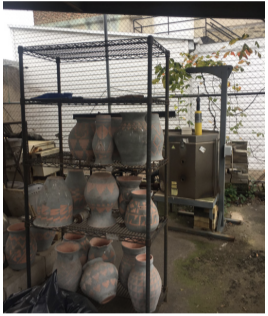Demolishing the Kiln: A Battle Between Athletics and Arts?
Tucked in the back parking lot next to the art studio wing were two powerful machines that fueled much of the ceramics program at Poly Prep—that is, until construction crews dismantled them last month with little notice to the arts department. These machines were kilns, handbuilt brick by brick over 20 years ago, used to dry, harden, and fire clay creations into pottery.
Yonghwi Kim, head ceramics teacher, said he was devastated when he walked out into the back parking lot and saw the maintenance crew disconnecting the kilns from the gas line to eventually demolish it. “I found out, a week before they took it down—not from [Laura Coppola, the head of visual arts], not from [Michael Robinson, the head of arts], but from a maintenance guy that a construction crew was going to take it down,” said Kim. “I spoke to [Coppola], and she didn’t know [the kiln was being removed] and she spoke to [Robinson] and he didn’t know. So who made that decision? We didn’t know. I still don’t know.”
After learning in September that the backfields renovation would extend into the back parking lot, Director of Operations Matt Stelluto gave the go-ahead to remove the kiln as it would be in the way of the field’s renovation. Head of School Audrius Barzdukas said, “As with every construction project, some existing structures must be relocated for safety and access reasons.”
“In order for the field project to continue I had to give the go-ahead to remove the kiln,” Stelluto wrote in an email to the Polygon.“The field installation company was not aware of the kiln location…The arts department was informed after we were. They were aware [of the plan to remove the kiln] prior to the kiln removal.”
While Kim has two electric kilns inside the ceramics studio, he explained that the outdoor gas kiln was about five times bigger, essential for firing bigger projects and pieces that come out of the studio. Chair of the Visual Arts Department Laura Coppola said, “The electric kiln can fire in smaller quantities and with lesser quality. [The kilns outside had] so much power that it could make those big sculptures look as gorgeous as they do.”
Coppola added that Poly is “doing this multimillion dollar expansion project of the backfields, and the bleachers are being extended basically where the kiln is. No one was informed of this. We just kind of happened upon it. We asked what happened, and it was an oversight. We wondered how such a big deal could be an oversight.”
The arts department is now attempting to formalize a plan to recover a replacement kiln, but has run into some significant problems. For starters, there is the issue of money. “If I get the new kiln, it will cost 70,000 dollars,” Kim said.
Time is another problem—it takes five to six months to order the kiln. The biggest issue, however, Coppola said, “is that [the construction crew] cut the gas line [to reconstruct the baseball bleachers]. [Replacing the gas line] could take years. That requires a utility company, it requires the city, it requires permits—and you need a location. If we have less space in the back parking lot, we don’t know where it goes.”
Kim is attempting to reconfigure the ceramics curriculum to accommodate smaller pieces to manage the two smaller electric kilns inside the studio. While sports is a key part of the Poly community, Barzdukas is acutely aware of the importance of the ceramics department at Poly. “We are considering all options now. The ceramics program is one of our school’s shining areas of creativity,” Barzdukas said. “Students have imagined and made true works of art in that kiln. We want the program to thrive into the future.”

Emma Spring '22 is currently an Editor-in-Chief of the Polygon. She began writing as a staff writer during her freshman year, became the Sports Editor...














































